Kent Institute Australia: Inventory System Report - DSAA204/BIT204
VerifiedAdded on 2022/10/17
|10
|2146
|168
Report
AI Summary
This report details the design of an inventory system for a company that manages household and food products. The report begins by identifying key variables, including product type, name, price, manufacturer, and expiry dates for food items, along with variables related to purchasing and suppliers. It defines key variables and ranges for the database. The report then describes various operations essential for an inventory system, such as safety stock level, setting order levels, economic order quantity, FIFO, ABC analysis, organization, and stock review methods. The core of the report focuses on the algorithms used, specifically the quick-sort algorithm for sorting and the binary search algorithm for searching, with justifications for their selection. The report also outlines proposed changes to the system to accommodate a potential merger, emphasizing scalability by adjusting variable ranges and maintaining the efficiency of the algorithms. The conclusion highlights the importance of effective system design for efficient data management and the overall growth of the company, referencing the identified variables, algorithms, and system methods.

Windows User
[COMPANY NAME] [Company address]
DATA STRUCTURE AND ALGORITHM
[COMPANY NAME] [Company address]
DATA STRUCTURE AND ALGORITHM
Paraphrase This Document
Need a fresh take? Get an instant paraphrase of this document with our AI Paraphraser
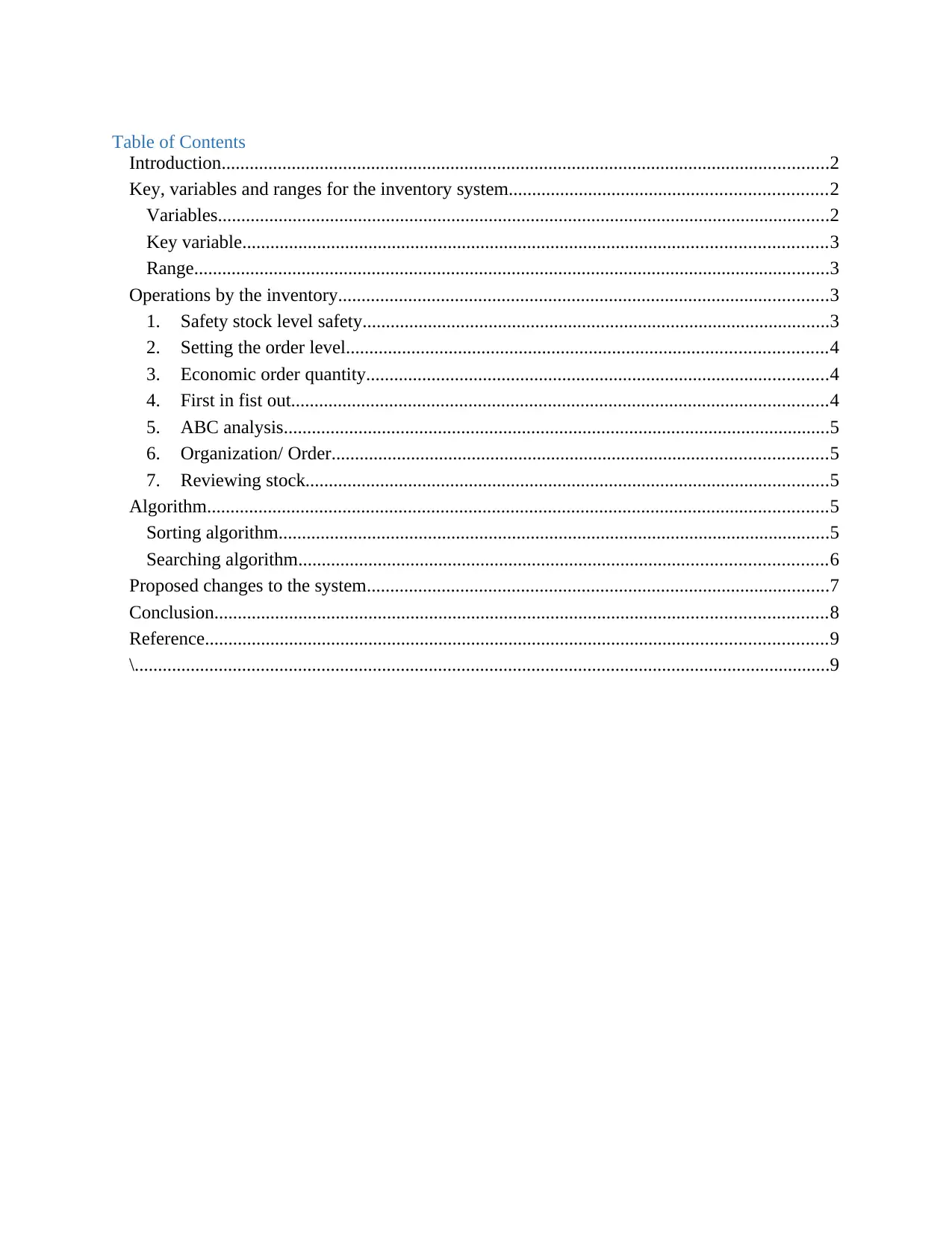
Table of Contents
Introduction..................................................................................................................................2
Key, variables and ranges for the inventory system....................................................................2
Variables...................................................................................................................................2
Key variable.............................................................................................................................3
Range........................................................................................................................................3
Operations by the inventory.........................................................................................................3
1. Safety stock level safety....................................................................................................3
2. Setting the order level.......................................................................................................4
3. Economic order quantity...................................................................................................4
4. First in fist out...................................................................................................................4
5. ABC analysis.....................................................................................................................5
6. Organization/ Order..........................................................................................................5
7. Reviewing stock................................................................................................................5
Algorithm.....................................................................................................................................5
Sorting algorithm......................................................................................................................5
Searching algorithm.................................................................................................................6
Proposed changes to the system...................................................................................................7
Conclusion...................................................................................................................................8
Reference.....................................................................................................................................9
\.....................................................................................................................................................9
Introduction..................................................................................................................................2
Key, variables and ranges for the inventory system....................................................................2
Variables...................................................................................................................................2
Key variable.............................................................................................................................3
Range........................................................................................................................................3
Operations by the inventory.........................................................................................................3
1. Safety stock level safety....................................................................................................3
2. Setting the order level.......................................................................................................4
3. Economic order quantity...................................................................................................4
4. First in fist out...................................................................................................................4
5. ABC analysis.....................................................................................................................5
6. Organization/ Order..........................................................................................................5
7. Reviewing stock................................................................................................................5
Algorithm.....................................................................................................................................5
Sorting algorithm......................................................................................................................5
Searching algorithm.................................................................................................................6
Proposed changes to the system...................................................................................................7
Conclusion...................................................................................................................................8
Reference.....................................................................................................................................9
\.....................................................................................................................................................9
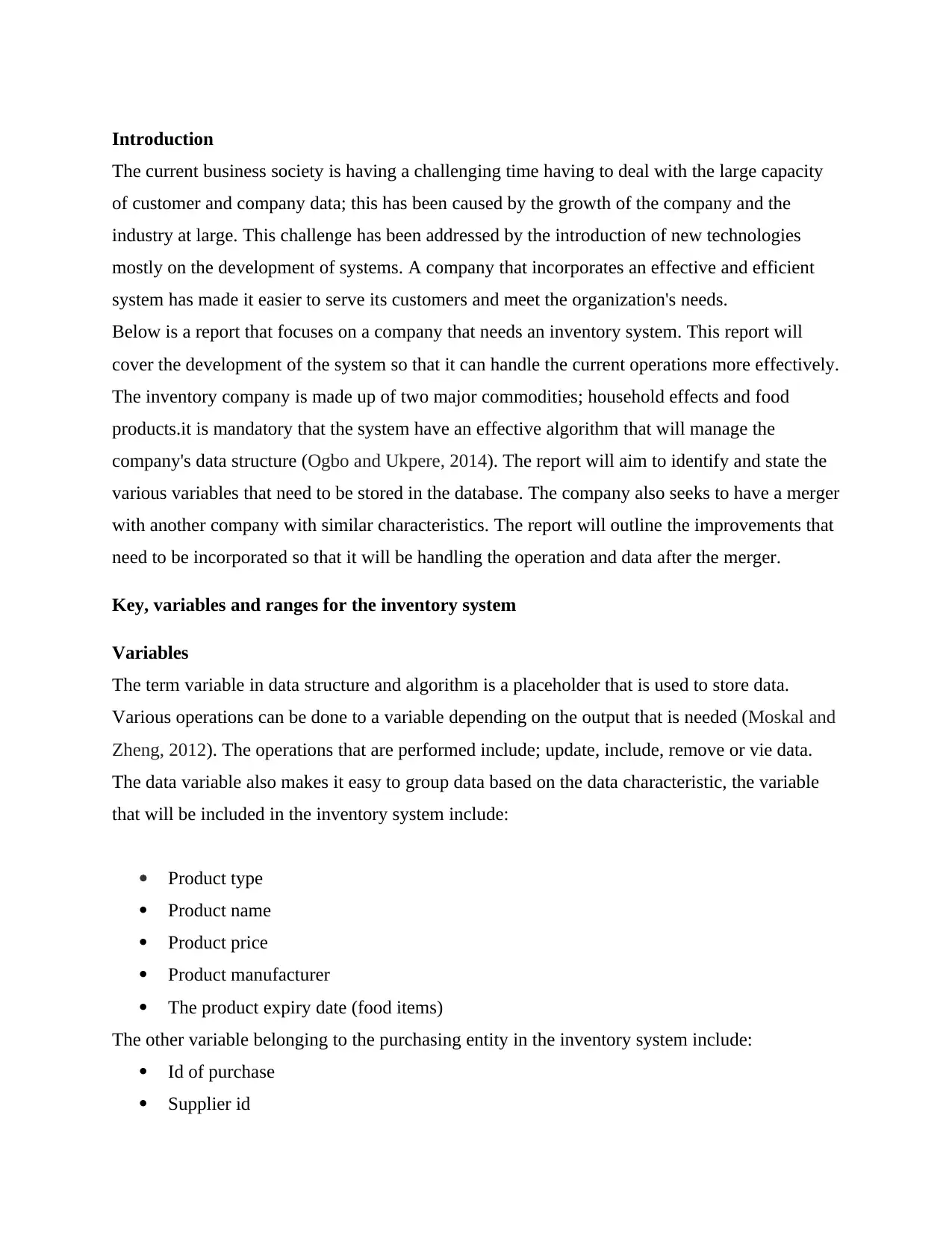
Introduction
The current business society is having a challenging time having to deal with the large capacity
of customer and company data; this has been caused by the growth of the company and the
industry at large. This challenge has been addressed by the introduction of new technologies
mostly on the development of systems. A company that incorporates an effective and efficient
system has made it easier to serve its customers and meet the organization's needs.
Below is a report that focuses on a company that needs an inventory system. This report will
cover the development of the system so that it can handle the current operations more effectively.
The inventory company is made up of two major commodities; household effects and food
products.it is mandatory that the system have an effective algorithm that will manage the
company's data structure (Ogbo and Ukpere, 2014). The report will aim to identify and state the
various variables that need to be stored in the database. The company also seeks to have a merger
with another company with similar characteristics. The report will outline the improvements that
need to be incorporated so that it will be handling the operation and data after the merger.
Key, variables and ranges for the inventory system
Variables
The term variable in data structure and algorithm is a placeholder that is used to store data.
Various operations can be done to a variable depending on the output that is needed (Moskal and
Zheng, 2012). The operations that are performed include; update, include, remove or vie data.
The data variable also makes it easy to group data based on the data characteristic, the variable
that will be included in the inventory system include:
Product type
Product name
Product price
Product manufacturer
The product expiry date (food items)
The other variable belonging to the purchasing entity in the inventory system include:
Id of purchase
Supplier id
The current business society is having a challenging time having to deal with the large capacity
of customer and company data; this has been caused by the growth of the company and the
industry at large. This challenge has been addressed by the introduction of new technologies
mostly on the development of systems. A company that incorporates an effective and efficient
system has made it easier to serve its customers and meet the organization's needs.
Below is a report that focuses on a company that needs an inventory system. This report will
cover the development of the system so that it can handle the current operations more effectively.
The inventory company is made up of two major commodities; household effects and food
products.it is mandatory that the system have an effective algorithm that will manage the
company's data structure (Ogbo and Ukpere, 2014). The report will aim to identify and state the
various variables that need to be stored in the database. The company also seeks to have a merger
with another company with similar characteristics. The report will outline the improvements that
need to be incorporated so that it will be handling the operation and data after the merger.
Key, variables and ranges for the inventory system
Variables
The term variable in data structure and algorithm is a placeholder that is used to store data.
Various operations can be done to a variable depending on the output that is needed (Moskal and
Zheng, 2012). The operations that are performed include; update, include, remove or vie data.
The data variable also makes it easy to group data based on the data characteristic, the variable
that will be included in the inventory system include:
Product type
Product name
Product price
Product manufacturer
The product expiry date (food items)
The other variable belonging to the purchasing entity in the inventory system include:
Id of purchase
Supplier id
⊘ This is a preview!⊘
Do you want full access?
Subscribe today to unlock all pages.

Trusted by 1+ million students worldwide
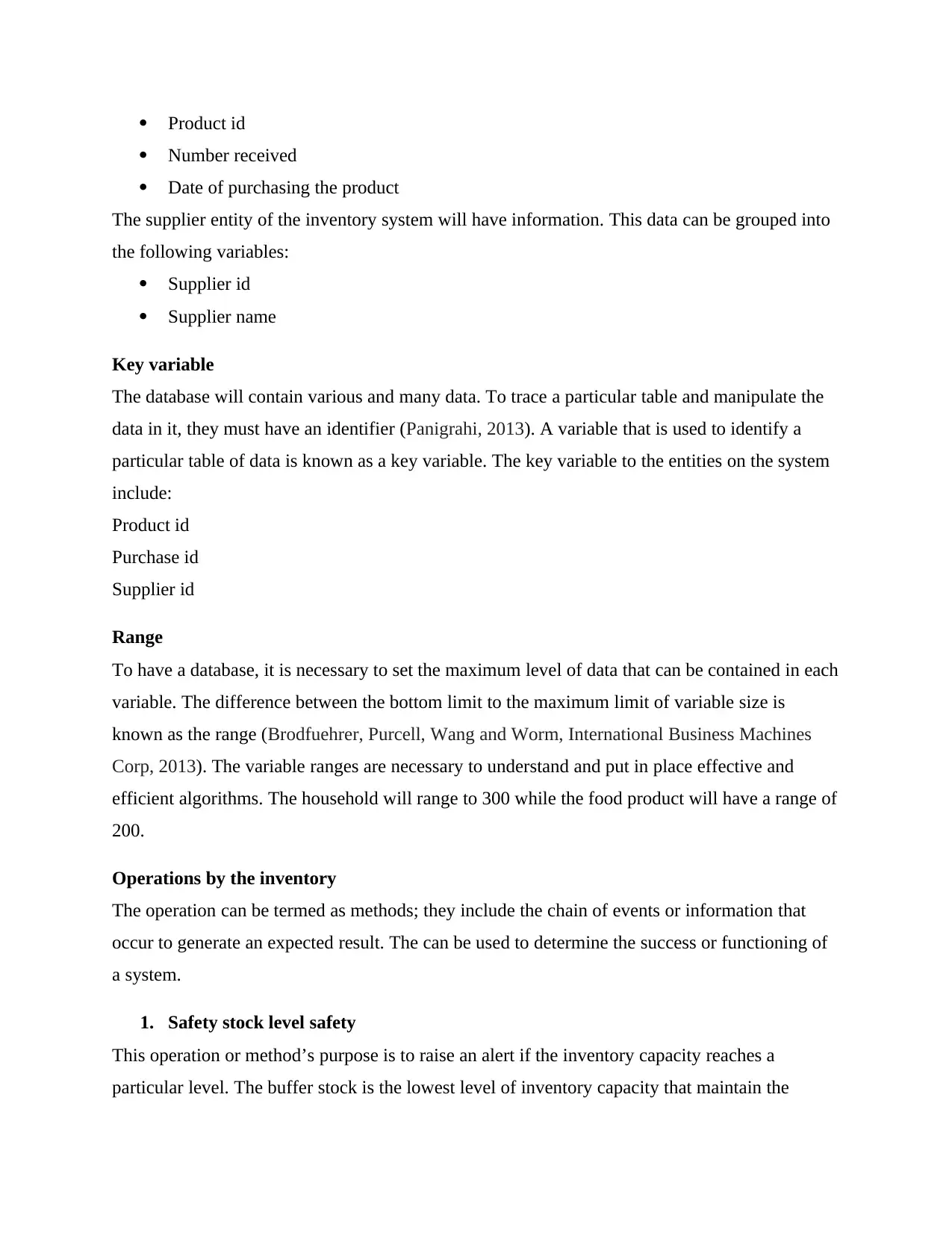
Product id
Number received
Date of purchasing the product
The supplier entity of the inventory system will have information. This data can be grouped into
the following variables:
Supplier id
Supplier name
Key variable
The database will contain various and many data. To trace a particular table and manipulate the
data in it, they must have an identifier (Panigrahi, 2013). A variable that is used to identify a
particular table of data is known as a key variable. The key variable to the entities on the system
include:
Product id
Purchase id
Supplier id
Range
To have a database, it is necessary to set the maximum level of data that can be contained in each
variable. The difference between the bottom limit to the maximum limit of variable size is
known as the range (Brodfuehrer, Purcell, Wang and Worm, International Business Machines
Corp, 2013). The variable ranges are necessary to understand and put in place effective and
efficient algorithms. The household will range to 300 while the food product will have a range of
200.
Operations by the inventory
The operation can be termed as methods; they include the chain of events or information that
occur to generate an expected result. The can be used to determine the success or functioning of
a system.
1. Safety stock level safety
This operation or method’s purpose is to raise an alert if the inventory capacity reaches a
particular level. The buffer stock is the lowest level of inventory capacity that maintain the
Number received
Date of purchasing the product
The supplier entity of the inventory system will have information. This data can be grouped into
the following variables:
Supplier id
Supplier name
Key variable
The database will contain various and many data. To trace a particular table and manipulate the
data in it, they must have an identifier (Panigrahi, 2013). A variable that is used to identify a
particular table of data is known as a key variable. The key variable to the entities on the system
include:
Product id
Purchase id
Supplier id
Range
To have a database, it is necessary to set the maximum level of data that can be contained in each
variable. The difference between the bottom limit to the maximum limit of variable size is
known as the range (Brodfuehrer, Purcell, Wang and Worm, International Business Machines
Corp, 2013). The variable ranges are necessary to understand and put in place effective and
efficient algorithms. The household will range to 300 while the food product will have a range of
200.
Operations by the inventory
The operation can be termed as methods; they include the chain of events or information that
occur to generate an expected result. The can be used to determine the success or functioning of
a system.
1. Safety stock level safety
This operation or method’s purpose is to raise an alert if the inventory capacity reaches a
particular level. The buffer stock is the lowest level of inventory capacity that maintain the
Paraphrase This Document
Need a fresh take? Get an instant paraphrase of this document with our AI Paraphraser
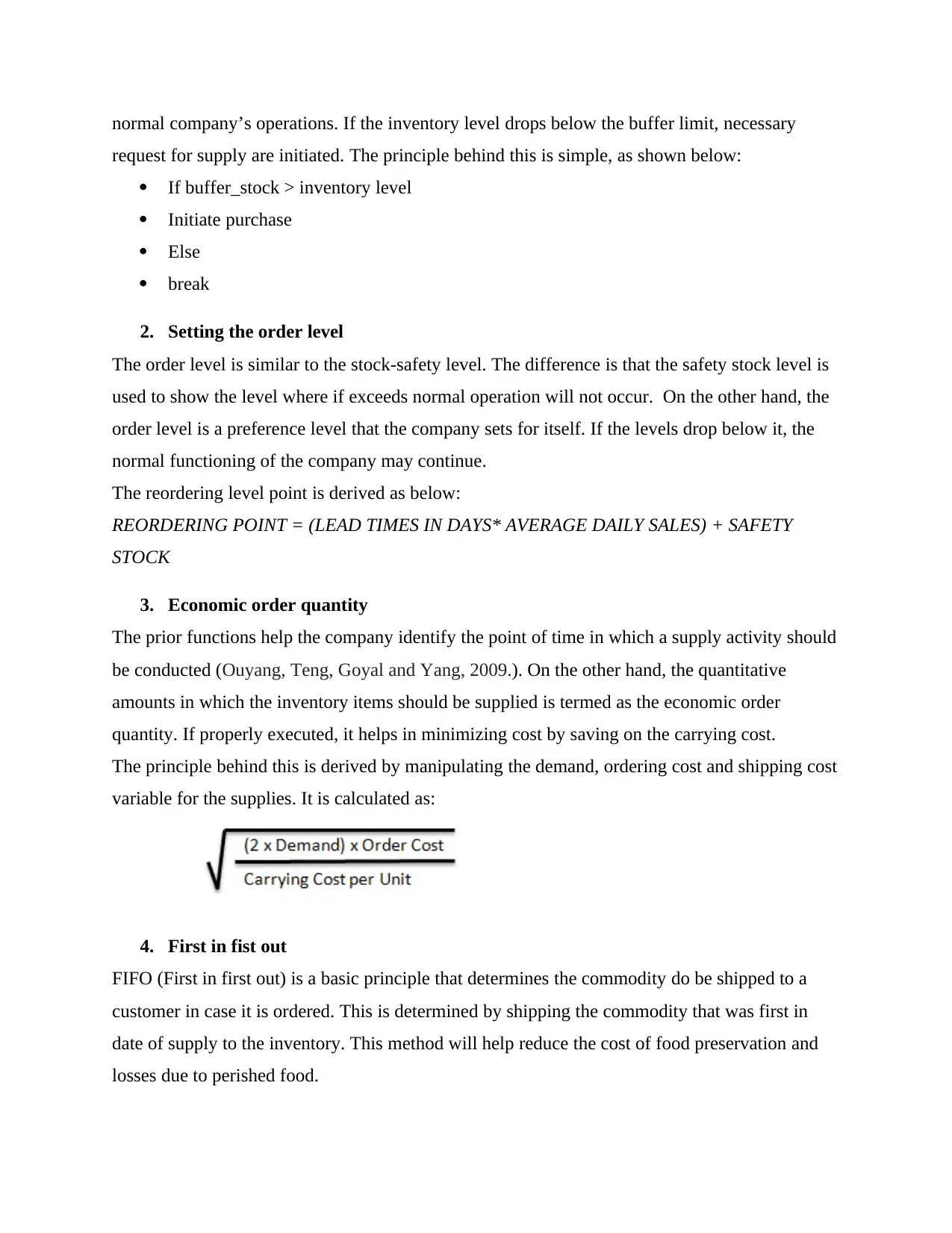
normal company’s operations. If the inventory level drops below the buffer limit, necessary
request for supply are initiated. The principle behind this is simple, as shown below:
If buffer_stock > inventory level
Initiate purchase
Else
break
2. Setting the order level
The order level is similar to the stock-safety level. The difference is that the safety stock level is
used to show the level where if exceeds normal operation will not occur. On the other hand, the
order level is a preference level that the company sets for itself. If the levels drop below it, the
normal functioning of the company may continue.
The reordering level point is derived as below:
REORDERING POINT = (LEAD TIMES IN DAYS* AVERAGE DAILY SALES) + SAFETY
STOCK
3. Economic order quantity
The prior functions help the company identify the point of time in which a supply activity should
be conducted (Ouyang, Teng, Goyal and Yang, 2009.). On the other hand, the quantitative
amounts in which the inventory items should be supplied is termed as the economic order
quantity. If properly executed, it helps in minimizing cost by saving on the carrying cost.
The principle behind this is derived by manipulating the demand, ordering cost and shipping cost
variable for the supplies. It is calculated as:
4. First in fist out
FIFO (First in first out) is a basic principle that determines the commodity do be shipped to a
customer in case it is ordered. This is determined by shipping the commodity that was first in
date of supply to the inventory. This method will help reduce the cost of food preservation and
losses due to perished food.
request for supply are initiated. The principle behind this is simple, as shown below:
If buffer_stock > inventory level
Initiate purchase
Else
break
2. Setting the order level
The order level is similar to the stock-safety level. The difference is that the safety stock level is
used to show the level where if exceeds normal operation will not occur. On the other hand, the
order level is a preference level that the company sets for itself. If the levels drop below it, the
normal functioning of the company may continue.
The reordering level point is derived as below:
REORDERING POINT = (LEAD TIMES IN DAYS* AVERAGE DAILY SALES) + SAFETY
STOCK
3. Economic order quantity
The prior functions help the company identify the point of time in which a supply activity should
be conducted (Ouyang, Teng, Goyal and Yang, 2009.). On the other hand, the quantitative
amounts in which the inventory items should be supplied is termed as the economic order
quantity. If properly executed, it helps in minimizing cost by saving on the carrying cost.
The principle behind this is derived by manipulating the demand, ordering cost and shipping cost
variable for the supplies. It is calculated as:
4. First in fist out
FIFO (First in first out) is a basic principle that determines the commodity do be shipped to a
customer in case it is ordered. This is determined by shipping the commodity that was first in
date of supply to the inventory. This method will help reduce the cost of food preservation and
losses due to perished food.
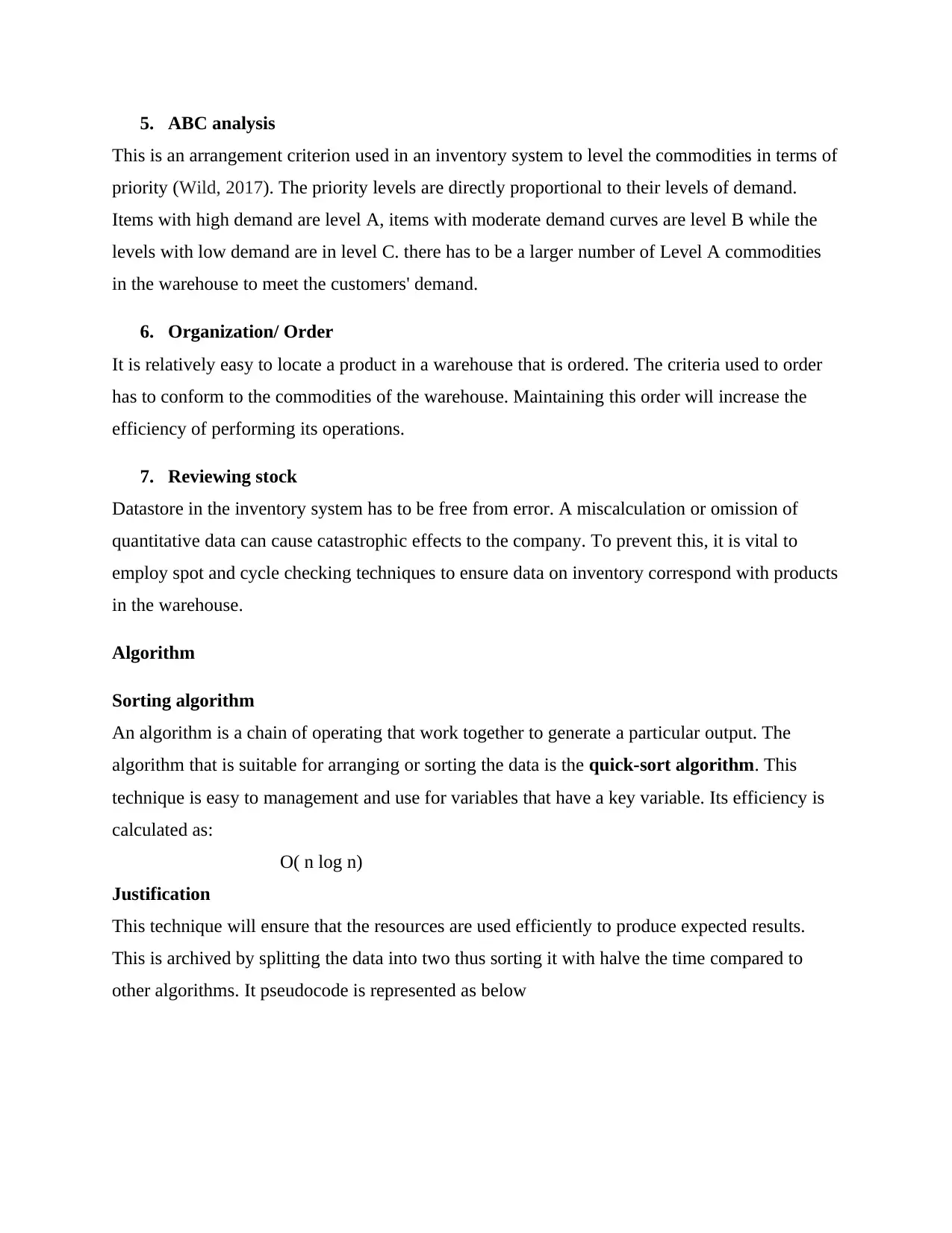
5. ABC analysis
This is an arrangement criterion used in an inventory system to level the commodities in terms of
priority (Wild, 2017). The priority levels are directly proportional to their levels of demand.
Items with high demand are level A, items with moderate demand curves are level B while the
levels with low demand are in level C. there has to be a larger number of Level A commodities
in the warehouse to meet the customers' demand.
6. Organization/ Order
It is relatively easy to locate a product in a warehouse that is ordered. The criteria used to order
has to conform to the commodities of the warehouse. Maintaining this order will increase the
efficiency of performing its operations.
7. Reviewing stock
Datastore in the inventory system has to be free from error. A miscalculation or omission of
quantitative data can cause catastrophic effects to the company. To prevent this, it is vital to
employ spot and cycle checking techniques to ensure data on inventory correspond with products
in the warehouse.
Algorithm
Sorting algorithm
An algorithm is a chain of operating that work together to generate a particular output. The
algorithm that is suitable for arranging or sorting the data is the quick-sort algorithm. This
technique is easy to management and use for variables that have a key variable. Its efficiency is
calculated as:
O( n log n)
Justification
This technique will ensure that the resources are used efficiently to produce expected results.
This is archived by splitting the data into two thus sorting it with halve the time compared to
other algorithms. It pseudocode is represented as below
This is an arrangement criterion used in an inventory system to level the commodities in terms of
priority (Wild, 2017). The priority levels are directly proportional to their levels of demand.
Items with high demand are level A, items with moderate demand curves are level B while the
levels with low demand are in level C. there has to be a larger number of Level A commodities
in the warehouse to meet the customers' demand.
6. Organization/ Order
It is relatively easy to locate a product in a warehouse that is ordered. The criteria used to order
has to conform to the commodities of the warehouse. Maintaining this order will increase the
efficiency of performing its operations.
7. Reviewing stock
Datastore in the inventory system has to be free from error. A miscalculation or omission of
quantitative data can cause catastrophic effects to the company. To prevent this, it is vital to
employ spot and cycle checking techniques to ensure data on inventory correspond with products
in the warehouse.
Algorithm
Sorting algorithm
An algorithm is a chain of operating that work together to generate a particular output. The
algorithm that is suitable for arranging or sorting the data is the quick-sort algorithm. This
technique is easy to management and use for variables that have a key variable. Its efficiency is
calculated as:
O( n log n)
Justification
This technique will ensure that the resources are used efficiently to produce expected results.
This is archived by splitting the data into two thus sorting it with halve the time compared to
other algorithms. It pseudocode is represented as below
⊘ This is a preview!⊘
Do you want full access?
Subscribe today to unlock all pages.

Trusted by 1+ million students worldwide
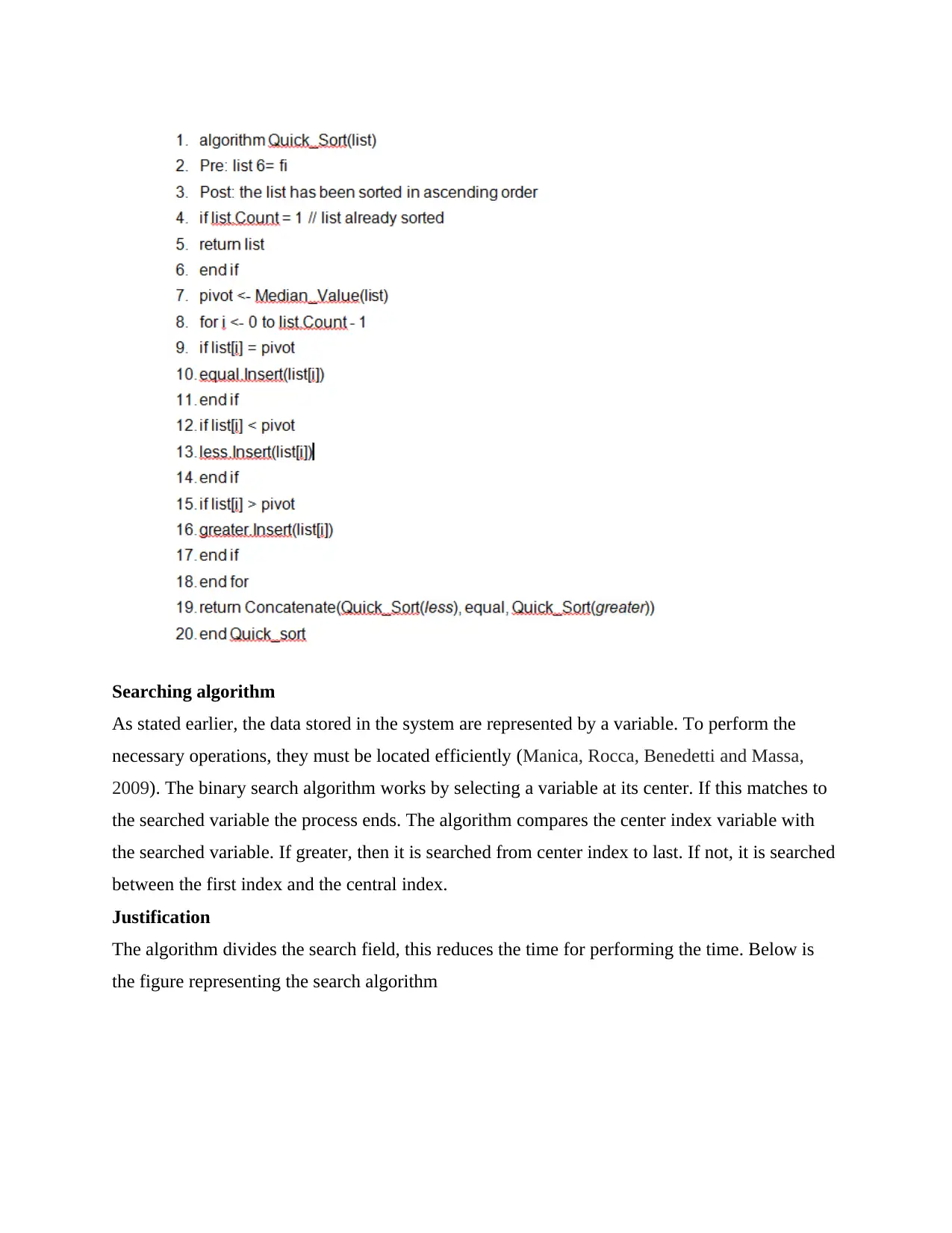
Searching algorithm
As stated earlier, the data stored in the system are represented by a variable. To perform the
necessary operations, they must be located efficiently (Manica, Rocca, Benedetti and Massa,
2009). The binary search algorithm works by selecting a variable at its center. If this matches to
the searched variable the process ends. The algorithm compares the center index variable with
the searched variable. If greater, then it is searched from center index to last. If not, it is searched
between the first index and the central index.
Justification
The algorithm divides the search field, this reduces the time for performing the time. Below is
the figure representing the search algorithm
As stated earlier, the data stored in the system are represented by a variable. To perform the
necessary operations, they must be located efficiently (Manica, Rocca, Benedetti and Massa,
2009). The binary search algorithm works by selecting a variable at its center. If this matches to
the searched variable the process ends. The algorithm compares the center index variable with
the searched variable. If greater, then it is searched from center index to last. If not, it is searched
between the first index and the central index.
Justification
The algorithm divides the search field, this reduces the time for performing the time. Below is
the figure representing the search algorithm
Paraphrase This Document
Need a fresh take? Get an instant paraphrase of this document with our AI Paraphraser
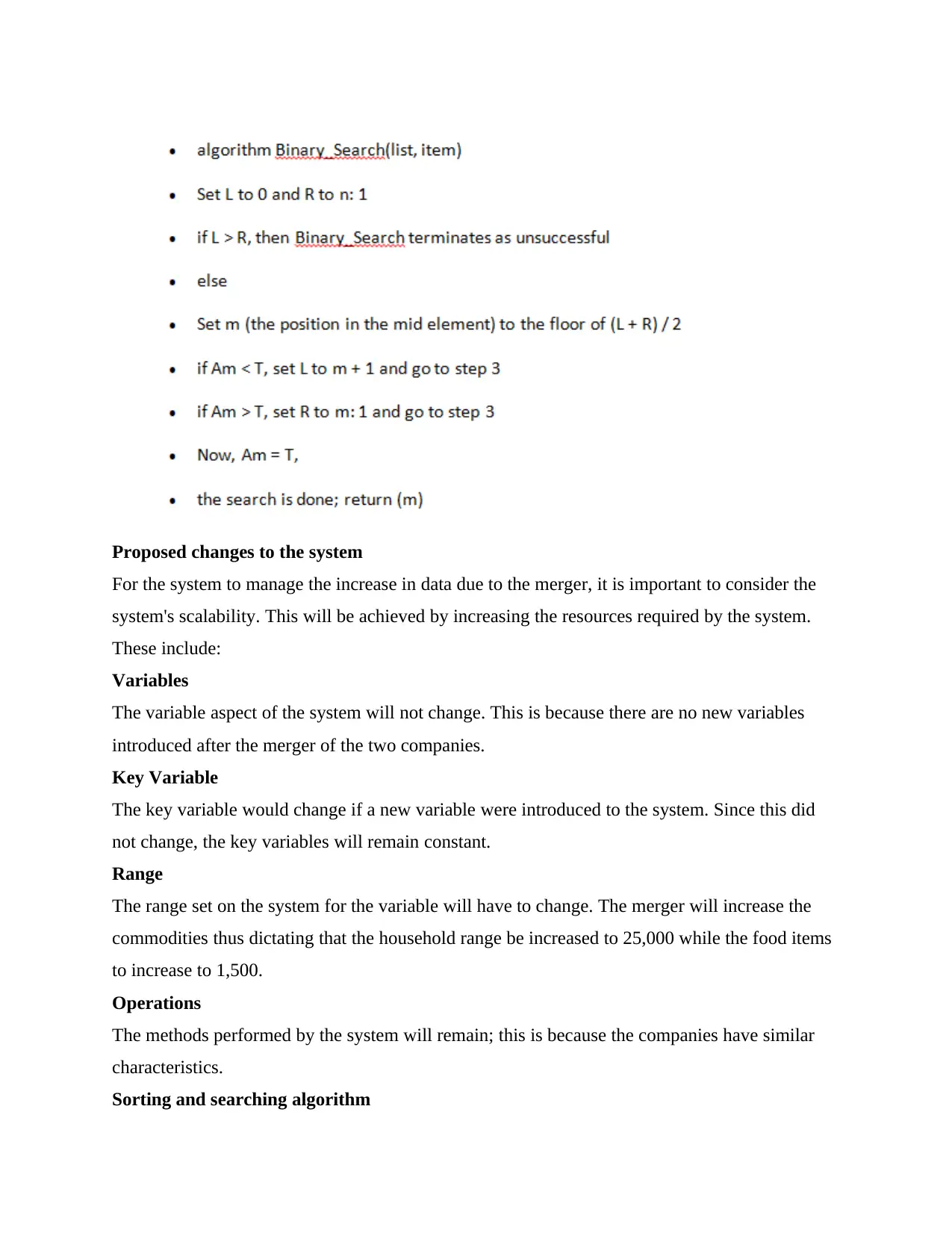
Proposed changes to the system
For the system to manage the increase in data due to the merger, it is important to consider the
system's scalability. This will be achieved by increasing the resources required by the system.
These include:
Variables
The variable aspect of the system will not change. This is because there are no new variables
introduced after the merger of the two companies.
Key Variable
The key variable would change if a new variable were introduced to the system. Since this did
not change, the key variables will remain constant.
Range
The range set on the system for the variable will have to change. The merger will increase the
commodities thus dictating that the household range be increased to 25,000 while the food items
to increase to 1,500.
Operations
The methods performed by the system will remain; this is because the companies have similar
characteristics.
Sorting and searching algorithm
For the system to manage the increase in data due to the merger, it is important to consider the
system's scalability. This will be achieved by increasing the resources required by the system.
These include:
Variables
The variable aspect of the system will not change. This is because there are no new variables
introduced after the merger of the two companies.
Key Variable
The key variable would change if a new variable were introduced to the system. Since this did
not change, the key variables will remain constant.
Range
The range set on the system for the variable will have to change. The merger will increase the
commodities thus dictating that the household range be increased to 25,000 while the food items
to increase to 1,500.
Operations
The methods performed by the system will remain; this is because the companies have similar
characteristics.
Sorting and searching algorithm
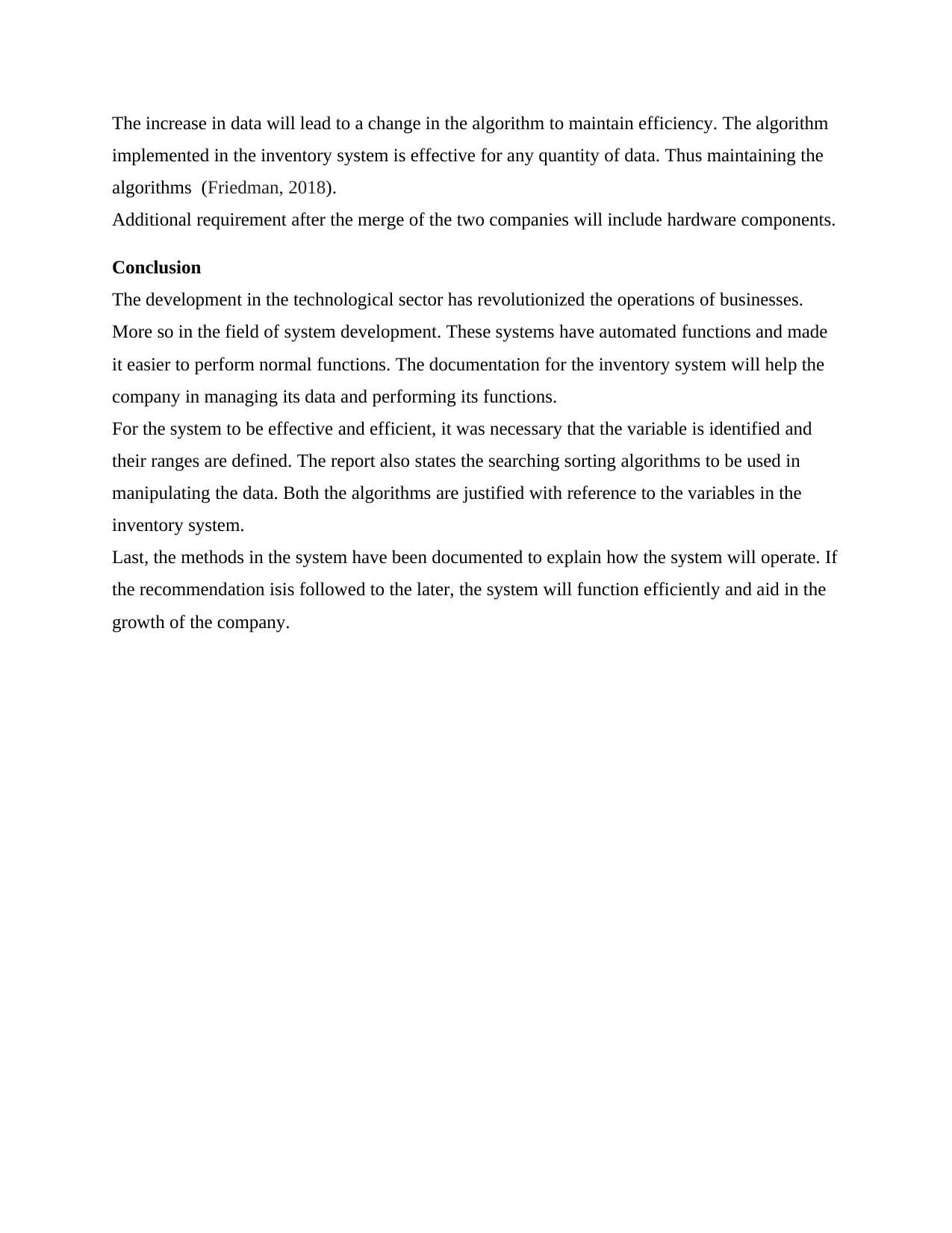
The increase in data will lead to a change in the algorithm to maintain efficiency. The algorithm
implemented in the inventory system is effective for any quantity of data. Thus maintaining the
algorithms (Friedman, 2018).
Additional requirement after the merge of the two companies will include hardware components.
Conclusion
The development in the technological sector has revolutionized the operations of businesses.
More so in the field of system development. These systems have automated functions and made
it easier to perform normal functions. The documentation for the inventory system will help the
company in managing its data and performing its functions.
For the system to be effective and efficient, it was necessary that the variable is identified and
their ranges are defined. The report also states the searching sorting algorithms to be used in
manipulating the data. Both the algorithms are justified with reference to the variables in the
inventory system.
Last, the methods in the system have been documented to explain how the system will operate. If
the recommendation isis followed to the later, the system will function efficiently and aid in the
growth of the company.
implemented in the inventory system is effective for any quantity of data. Thus maintaining the
algorithms (Friedman, 2018).
Additional requirement after the merge of the two companies will include hardware components.
Conclusion
The development in the technological sector has revolutionized the operations of businesses.
More so in the field of system development. These systems have automated functions and made
it easier to perform normal functions. The documentation for the inventory system will help the
company in managing its data and performing its functions.
For the system to be effective and efficient, it was necessary that the variable is identified and
their ranges are defined. The report also states the searching sorting algorithms to be used in
manipulating the data. Both the algorithms are justified with reference to the variables in the
inventory system.
Last, the methods in the system have been documented to explain how the system will operate. If
the recommendation isis followed to the later, the system will function efficiently and aid in the
growth of the company.
⊘ This is a preview!⊘
Do you want full access?
Subscribe today to unlock all pages.

Trusted by 1+ million students worldwide
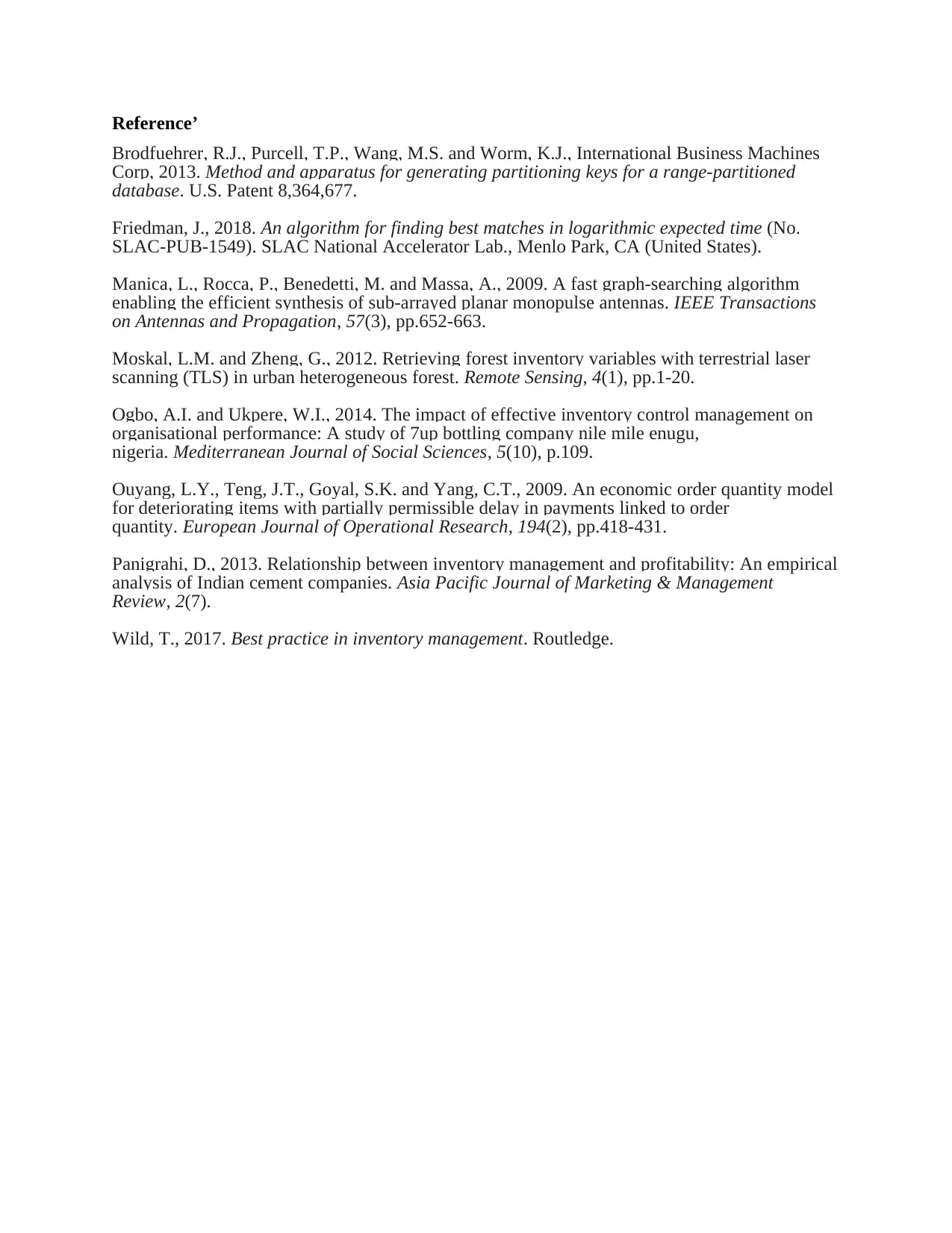
Reference’
Brodfuehrer, R.J., Purcell, T.P., Wang, M.S. and Worm, K.J., International Business Machines
Corp, 2013. Method and apparatus for generating partitioning keys for a range-partitioned
database. U.S. Patent 8,364,677.
Friedman, J., 2018. An algorithm for finding best matches in logarithmic expected time (No.
SLAC-PUB-1549). SLAC National Accelerator Lab., Menlo Park, CA (United States).
Manica, L., Rocca, P., Benedetti, M. and Massa, A., 2009. A fast graph-searching algorithm
enabling the efficient synthesis of sub-arrayed planar monopulse antennas. IEEE Transactions
on Antennas and Propagation, 57(3), pp.652-663.
Moskal, L.M. and Zheng, G., 2012. Retrieving forest inventory variables with terrestrial laser
scanning (TLS) in urban heterogeneous forest. Remote Sensing, 4(1), pp.1-20.
Ogbo, A.I. and Ukpere, W.I., 2014. The impact of effective inventory control management on
organisational performance: A study of 7up bottling company nile mile enugu,
nigeria. Mediterranean Journal of Social Sciences, 5(10), p.109.
Ouyang, L.Y., Teng, J.T., Goyal, S.K. and Yang, C.T., 2009. An economic order quantity model
for deteriorating items with partially permissible delay in payments linked to order
quantity. European Journal of Operational Research, 194(2), pp.418-431.
Panigrahi, D., 2013. Relationship between inventory management and profitability: An empirical
analysis of Indian cement companies. Asia Pacific Journal of Marketing & Management
Review, 2(7).
Wild, T., 2017. Best practice in inventory management. Routledge.
Brodfuehrer, R.J., Purcell, T.P., Wang, M.S. and Worm, K.J., International Business Machines
Corp, 2013. Method and apparatus for generating partitioning keys for a range-partitioned
database. U.S. Patent 8,364,677.
Friedman, J., 2018. An algorithm for finding best matches in logarithmic expected time (No.
SLAC-PUB-1549). SLAC National Accelerator Lab., Menlo Park, CA (United States).
Manica, L., Rocca, P., Benedetti, M. and Massa, A., 2009. A fast graph-searching algorithm
enabling the efficient synthesis of sub-arrayed planar monopulse antennas. IEEE Transactions
on Antennas and Propagation, 57(3), pp.652-663.
Moskal, L.M. and Zheng, G., 2012. Retrieving forest inventory variables with terrestrial laser
scanning (TLS) in urban heterogeneous forest. Remote Sensing, 4(1), pp.1-20.
Ogbo, A.I. and Ukpere, W.I., 2014. The impact of effective inventory control management on
organisational performance: A study of 7up bottling company nile mile enugu,
nigeria. Mediterranean Journal of Social Sciences, 5(10), p.109.
Ouyang, L.Y., Teng, J.T., Goyal, S.K. and Yang, C.T., 2009. An economic order quantity model
for deteriorating items with partially permissible delay in payments linked to order
quantity. European Journal of Operational Research, 194(2), pp.418-431.
Panigrahi, D., 2013. Relationship between inventory management and profitability: An empirical
analysis of Indian cement companies. Asia Pacific Journal of Marketing & Management
Review, 2(7).
Wild, T., 2017. Best practice in inventory management. Routledge.
1 out of 10
Related Documents
Your All-in-One AI-Powered Toolkit for Academic Success.
+13062052269
info@desklib.com
Available 24*7 on WhatsApp / Email
![[object Object]](/_next/static/media/star-bottom.7253800d.svg)
Unlock your academic potential
Copyright © 2020–2025 A2Z Services. All Rights Reserved. Developed and managed by ZUCOL.





